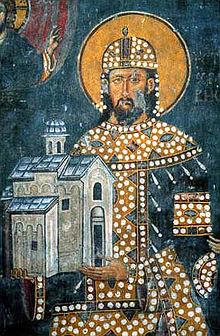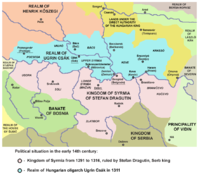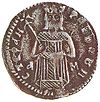- Stephen Dragutin of Serbia
-
"Dragutin" redirects here. For other uses, see Dragutin (name).
Stephen Dragutin
Стефан Драгутин
Stephen Dragutin, fresco from St. Achilleos church near Arilje, detail, 1296 King of Serbia Reign 1276–1282 Predecessor Stephen Uroš I Successor Stephen Uroš II Milutin Spouse Catherine of Hungary Issue Stephen Vladislav II of Syrmia
Elizabeth, Banness of Bosnia
UrošicHouse House of Nemanjić Father Stephen Uroš I of Serbia Mother Helen of Anjou Died March 12, 1316 Burial Đurđevi Stupovi Religion Christian Stephen Dragutin (Serbian: Стефан Драгутин, Stefan Dragutin; died March 12, 1316) was a 13th and 14th-century Serb monarch, the King of Serbia from 1276 to 1282 and King of Syrmia (Srem) from 1282 to 1316.
He ruled Serbia until his abdication in 1282, when he became ill. He continued to rule the royal domains of Syrmia as King of Syrmia, and his younger brother succeeded him as ruler of Serbia.
Contents
Life
Dragutin was the eldest son of king Stephen Uroš I of Serbia by Helen of Anjou. He married Catherine, daughter of Hungarian king Stephen V. He was the leading Hungarophile in Serbian politics, and because of this he came in conflict with his father, from whom he then usurped the throne in 1276 with help of Hungary, after a clash with his forces at Battle of Gacko. He began to attack the Byzantine Empire but had no success.
In 1282 he broke his leg while hunting and became ill; he passed the throne to his younger brother Stefan Milutin at the council at Deževo 1282, while keeping for himself some northern parts of the country. Since his son Vladislav married the relative of a Hungarian king, Dragutin in 1284 gained from Ladislaus IV areas of Mačva with Belgrade, and the Bosnian areas Soli and Usora, which he ruled until 1316, establishing family relations with Bosnian ban Stephen I Kotromanić. His new state was named Kingdom of Srem. The first capital of his state was Debrc (between Belgrade and Šabac), and later he moved his residence to Belgrade. He is the first of the Serb rulers who ruled from the capital of Belgrade.
 Kingdom of Srem of Stefan Dragutin with its northern borders on Sava and Danube rivers (according to the opinion of most historians)
Kingdom of Srem of Stefan Dragutin with its northern borders on Sava and Danube rivers (according to the opinion of most historians)
 Kingdom of Srem of Stefan Dragutin with borders that are including Upper Srem (according to historian Stanoje Stanojević)
Kingdom of Srem of Stefan Dragutin with borders that are including Upper Srem (according to historian Stanoje Stanojević)
In that time the name Srem was designation for two territories: Upper Srem (present day Srem) and Lower Srem (present day Mačva). Kingdom of Srem under the rule of Stefan Dragutin was actually Lower Srem. Some historical sources mention that Stefan Dragutin also ruled over Upper Srem and Slavonija, but the other sources mention another local ruler who ruled over Upper Srem. The name of this ruler was Ugrin Csák.
Near the end of the 13th century Stefan Dragutin expanded his territory, adding Braničevo[disambiguation needed
 ] and Kučevo. He came into conflict with his brother Milutin when Milutin wanted to create stronger political ties with the Byzantine Empire and obviously did not intend to give the throne to Dragutin's son Vladislav as agreed. Conflict between the brothers was calmed by the clergy in 1313. Near the end of his life he separated from his Hungarian friends and strengthened his connections in Serbia. He later became a monk and changed his name to Teoktist. He died in 1316 and was buried in the Đurđevi Stupovi monastery near Novi Pazar. After Dragutin died, his son Stefan Vladislav II became the new ruler of the Kingdom of Srem.
] and Kučevo. He came into conflict with his brother Milutin when Milutin wanted to create stronger political ties with the Byzantine Empire and obviously did not intend to give the throne to Dragutin's son Vladislav as agreed. Conflict between the brothers was calmed by the clergy in 1313. Near the end of his life he separated from his Hungarian friends and strengthened his connections in Serbia. He later became a monk and changed his name to Teoktist. He died in 1316 and was buried in the Đurđevi Stupovi monastery near Novi Pazar. After Dragutin died, his son Stefan Vladislav II became the new ruler of the Kingdom of Srem.His legacy includes some splendid monasteries, most notable among them: monastery Mala Remeta on Fruška Gora, dedicated to the Shroud of the Mother of God; St. Achillios church near Arilje (1296); and a monastery Đurđevi stupovi with St. George church in Ras (now Novi Pazar), where he was buried.
Family
His marriage in about 1268 with Katarina, daughter of Stephen V of Hungary and Elizabeth the Cuman, produced three children:[1][2]
- Stefan Vladislav II, king of Srem (1316–1325).
- Elizabeth of Serbia, married in 1284 to Stephen I, Ban of Bosnia, becoming mother of Stephen II, Ban of Bosnia.
- Urošic (Урошиц), died as a monk.
See also
- Saint Achillius Church
- History of Serbia
- List of Serbian monarchs
- Srem
Stephen Dragutin of SerbiaDied: 12 March 1316Regnal titles Preceded by
Stefan Uroš IKing of Serbia
1276–1282Succeeded by
Stefan Uroš II MilutinPreceded by
new titleKing of Syrmia
1282–1316Succeeded by
Stefan Vladislav IIReferences
- John V.A. Fine, Jr., The Late Medieval Balkans, Ann Arbor, 1987.
- Miomir Filipović - Fića, Tri cara i trideset i jedan kralj srpskog naroda, Čikago, 1992.
- Drago Njegovan, Prisajedinjenje Vojvodine Srbiji, Novi Sad, 2004.
- Small encyclopedia "Sveznanje" published by "Narodno delo", Belgrade, in 1937 which is today in public domain. This article is written from the point of view of that place and time and may not reflect modern opinions or recent discoveries.
- Age, marriage and progeny information from The genealogy and coats of arms of Serbian dynasties and feudals (Родословне таблице и грбови српских династија и властеле); editors Aleksa Ivić (1928), Dušan Spasić, Aleksandar Palavestra and Dušan Mrđenović (1987); Bata, Belgrade, ISBN 86-7685-007-0 (1928), ISBN 86-7335-050-6 (1987) (in Serbian language).
External links
- Map of Dragutin's realm
- Map of Dragutin's realm
- Map of Dragutin's realm
- Map of Dragutin's realm
- Map of Dragutin's realm (from book "Hrvatska povijest u 25 karata", written by Stjepan Srkulj and Josip Lučić)
 House of Nemanjić
House of Nemanjić 
Main ruling members see family tree · Stefan Nemanja · Stefan Prvovenčani · Vukan Nemanjić · Stefan Radoslav · Stefan Vladislav I · Stefan Uroš I · Stefan Dragutin · Stefan (Uroš II) Milutin · Stefan Vladislav II · Stefan (Uroš III) Dečanski · Stefan (Uroš IV) Dušan · Stefan Uroš VOther ruling members Archbishops Minor members Vratislav Nemanjić · Vratko Nemanjić · Urošica · Dmitar Nemanjić · Stefan Vukanović · Radoslav Hlapenx · Vojihnax · Balša IxFemale members Jefimija · Komnena · Jelena Šubić · Jelisaveta · Anna Neda Shishman · Theodora · Milica · St. Jelena of DečaniConsorts St. Anastasija · Eudokia Angelina · Anna Dandolo · Anna Doukaina · Beloslava · Helen of Anjou · Catherine · Helena Doukaina Angelina · Elisabeth · Anna Terter · Simonida · Theodora Smilets · Maria Palaiologina · Helena · Anna BasarabaMonarchs of Serbia 1st Serbian Principality 641–969 Unknown Archont · Višeslav · Radoslav · Prosigoj · Vlastimir · Mutimir · Pribislav · Petar · Pavle · Zaharija · Časlav · annexation, Duklja emerging as seat2nd Serbian Principality
(Duklja)998–1101 Jovan Vladimir · Stefan Vojislav · Mihailo I · Constantine Bodin · Rascia re-emerging as seat (Grand Principality of Serbia)Serbian Grand Principality 1101–1217Vukan · Uroš I · Uroš II · Beloš · Desa · Tihomir · Stefan Nemanja · Stefan II · Proclamation of KingdomSerbian Kingdom 1217–1346Stefan II · Stefan Radoslav · Stefan Vladislav I · Stefan Uroš I · Stefan Dragutin ( · Stefan Vladislav II at Syrmia) · Stefan Uroš II Milutin · Stefan Konstantin · Stefan Uroš III Dečanski · Stefan Uroš IV Dušan · Proclamation of EmpireSerbian Empire 1346–1371Serbian Lordship and Despotate 1371–1537Lazar · Stefan Lazarević · Đurađ Branković · Lazar Branković · Stefan Branković · Stefan Tomašević · Ottoman annexation, titular: · Vuk Grgurević · Đorđe Branković · Jovan Branković · Ivaniš Berislavić · Stevan Berislavić · Radič Božić · Pavle Bakić · Stefan Štiljanović · Ottoman annexationRevolutionary Serbia 1804–1837Principality of Serbia 1837–1882Miloš I · Milan II · Mihailo III · Aleksandar · Miloš I · Mihailo III · Milan IV · Proclamation of KingdomKingdom of Serbia 1882–1918Milan I · Alexander · Petar I · Proclamation of Kingdom of Yugoslavia · Proclamation of SFR YugoslaviaCategories:- House of Nemanjić
- 1316 deaths
- 13th-century Serbian monarchs
- 14th-century Serbian monarchs
- History of Vojvodina
- History of Syrmia
- Orthodox monarchs
Wikimedia Foundation. 2010.


